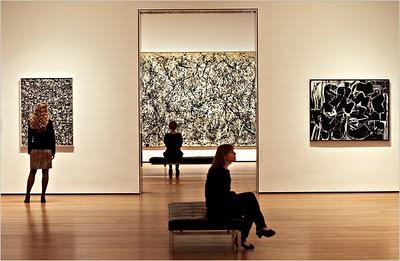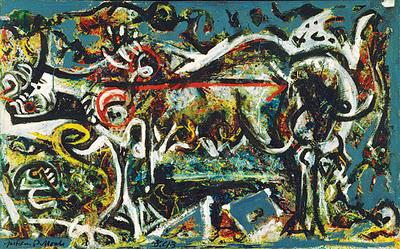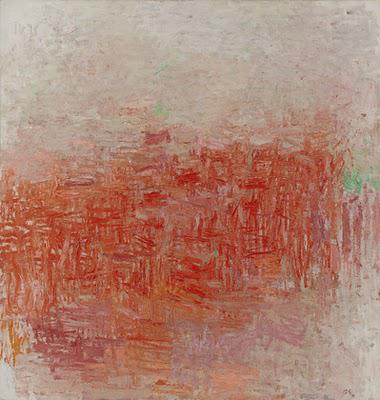 From left, Lee Krasner's Untitled (1949), Jackson Pollock's One: Number 31, 1950 andWillem de Kooning's Painting (1948) — via The New York Times
From left, Lee Krasner's Untitled (1949), Jackson Pollock's One: Number 31, 1950 andWillem de Kooning's Painting (1948) — via The New York TimesJerry Saltz advices of eleven pieces you can't miss when visiting MoMA's Abstract Expressionist New York exhibition. Among them Pollock's She-Wolf and One:Number 31, Gorky's Sochi, Newman's Vir Heroicus Sublimis, De Kooning's Woman, I and Ad Reinhart's Abstract Painting. And though this list is perfectly constructed in its ability to demonstrate the narrative of the Ab.Ex. style in eleven pieces, I'd say go on and enjoy the whole exhibit as a whole. It makes for quite an awesome day.
The exhibition is a true gem as the whole of it is composed by works pulled solely from the museum's collection, which is arguably the most complete collection of Ab.Ex. works there is out there. For it was MoMA after all—though we could easily credit Alfred Barr alone— who in the 1940's began to build a collection, which has single-handedly shaped the history of Modernity in art.
Walk in prepared to be confronted by the crowds of people gathered around She-Wolf, both awed yet unaware of the surrealism that oozes out of the canvas. Somewhat brilliantly Ann Temkin, the curator, surrounds the piece with Thomas Hart Benton and Richard Poussett-Dart, whose works highlight more than contrast the figurative nature of Pollock's early work.

Jackson Pollock, The She-Wolf (1943)
I truly felt that rather from trying to assert the anti-figurative feeling of the Abstract movement, the exhibit serves as a reminder that representation won most of the battle. Further along in the exhibit, De Kooning's 1948 Painting summons unrecognizable, but somewhat familiar shapes. And we are not wrong to think we see 'things' in it, as the artist himself reminds us: "Even abstract shapes must have a likeness." With that we are free to go on, unafraid to recognize a certain 'likeness' in Pollock's Echo or in Rothko's Slow Swirl at the Edge of the Sea.There is certainly plenty of space to marvel at the artist's extreme "desperation" to—as Jerry Saltz puts it— "shatter all that had come before it; technique and skill were completely reimagined and emotion was everything." Barnett Newman, Ad Reinhart, and Franz Klein feature prominently. Rothko even has a whole gallery devoted to his color fields.
There is a flirtation with figuration, with Cubism and primal expression throughout the exhibit that beautifully reinforces the artists' strong need to break free from convention. It also does well in expressing the inherent shock value of the movement, which is a primordial factor to its influence in history. Abstract Expressionism confronts you with the issue right away. Where Caravaggio's David With the Head of Goliath shocks you with the severed head and the dripping of blood, Phillip Guston gives you blood, and blood alone.

Phillip Guston, Painting (1954)
In the end, the irony becomes obvious. As the 50's come along—Ab.Ex was extremely short lived—we'll be shocked with what we were trying to get rid of to begin with. The obvious. The everyday (granted it was a different kind of eveyday). Something figurative. Something detached. POP.
Jasper Johns, Flag (1954-55)
Exhibit runs through April 25th, 2011 | MoMA

